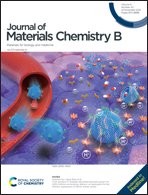A diketopyrrolopyrrole-based ratiometric fluorescent probe for endogenous leucine aminopeptidase detecting and imaging with specific phototoxicity in tumor cells†
Abstract
Leucine aminopeptidase (LAP) is a vital proteolytic enzyme, and its overexpression is often associated with many physiological diseases, such as liver dysfunction and breast cancer. Therefore, the accurate measurement of LAP concentrations in cells is critical for the diagnosis and prevention of related diseases. Herein, a new ratiometric fluorescent probe, DPP-Leu, based on diketopyrrolopyrrole (DPP) was designed and synthesized for LAP detection based on the specific enzymatic cleavage of the N-terminal leucine residue. The fluorescence intensity ratio of DPP-Leu (I548/I651) showed a remarkable change in the presence of LAP, with a limit of detection of 0.011 U L−1, and DPP-Leu was successfully applied to detect LAP in fetal bovine serum (FBS) and artificial urine. Cell imaging experiments revealed that DPP-Leu could target mitochondria and distinguish tumor cells with high LAP content from normal cells. Importantly, benefiting from the structural transformation of DPP-Leu to the photosensitizer 4 under LAP catalysis, the probe could kill tumor cells under light irradiation without damaging normal cells.



 Please wait while we load your content...
Please wait while we load your content...